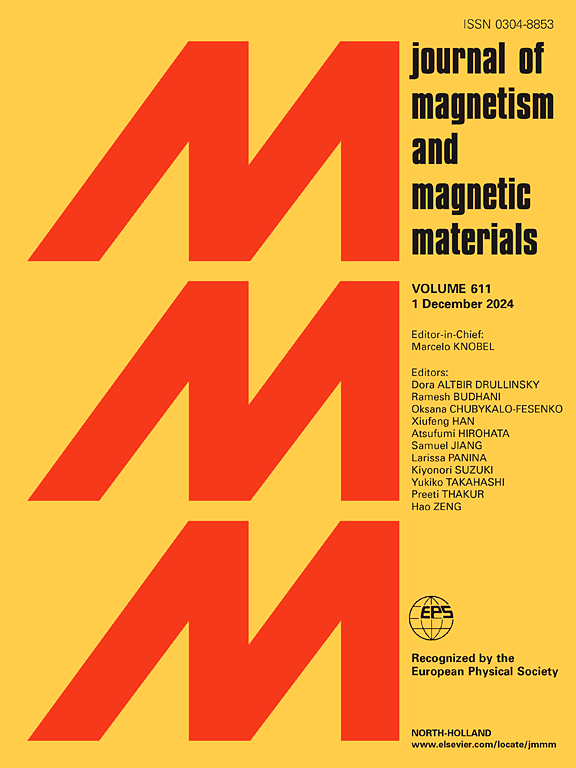常温Heusler铁磁体:CuMnCrAl、niifecral、Ni0.5Fe1.5CrAl的实验与理论研究Co2CrAl化合物的一种共价类似物
IF 2.5
3区 材料科学
Q3 MATERIALS SCIENCE, MULTIDISCIPLINARY
引用次数: 0
摘要
一些Heusler化合物,特别是Co2CrAl,由于其半金属铁磁体(HMF)特性以及室温下的磁有序性,其潜在的自旋电子应用已经得到了广泛的研究。在这里,我们报告了这种化合物的共价类似物,我们用元素周期表中的邻近元素取代了昂贵而有问题的钴,以一种我们保留价电子数量的方式。这些化合物以前没有经过实验研究。我们的XRD测量结果表明,它们以Heusler结构结晶,而我们的磁化测量结果表明,CuMnCrAl, NiFeCrAl, Ni0.5Fe1.5CrAl的磁有序温度分别高于Co2CrAl - 354k, 541k和465k。我们还提供了Cu0.5Mn0.5Ni0.5Fe0.5CrAl的数据,它也是磁性的,但温度较低。在较高温度下的磁化率测量表明,磁序是铁磁性的,其中一些磁亚晶格与其他磁亚晶格反平行。我们的DFT计算与Mössbauer光谱研究和磁化数据的比较也证实了这一点。在我们的从头计算中,我们还将XX 'YZ四元Heusler结构的三种可能的结构模型与Mössbauer和磁化数据进行了比较,并得出之前声称的NiFeCrAl中的HMF状态是否可能。我们还证明了完全无序结构(合金)的磁矩是保留的,并且它们比实验观察到的要高。本文章由计算机程序翻译,如有差异,请以英文原文为准。
Experimental and theoretical study of room temperature Heusler ferrimagnets: CuMnCrAl, NiFeCrAl, Ni0.5Fe1.5CrAl; An aliovalent analogs of the Co2CrAl compound
Some Heusler compounds, particularly CoCrAl, have been extensively studied due to their potential spintronic applications related to their half-metallic ferromagnet (HMF) properties, as well as magnetic ordering near room temperature. Here, we report aliovalent analogs to that compound, where we replaced expensive and problematic cobalt with its neighboring elements in the periodic table, in a way that we conserved the number of valence electrons. These compounds were not studied experimentally before. Our XRD measurements show that they crystallize in the Heusler structure, whereas our magnetization measurements show that CuMnCrAl, NiFeCrAl, Ni0.5Fe1.5CrAl have higher magnetic ordering temperatures than CoCrAl — 354 K, 541 K, and 465 K, respectively.
We also present data for Cu0.5Mn0.5Ni0.5Fe0.5CrAl which is magnetic too, but at lower temperatures. Susceptibility measurements at higher temperatures show that the magnetic order is ferrimagnetic, with some magnetic sublattices antiparallel to others. It is also confirmed by comparison of our DFT calculations with Mössbauer spectroscopy investigations and magnetization data. In our ab initio calculations, we also compare the three structural models possible for XX’YZ quaternary Heusler structure with Mössbauer and magnetization data, and conclude whether previously claimed HMF state in NiFeCrAl is possible. We also have shown that for completely disordered structure (alloy) the magnetic moments are preserved, and they are higher than experimentally observed.
求助全文
通过发布文献求助,成功后即可免费获取论文全文。
去求助
来源期刊

Journal of Magnetism and Magnetic Materials
物理-材料科学:综合
CiteScore
5.30
自引率
11.10%
发文量
1149
审稿时长
59 days
期刊介绍:
The Journal of Magnetism and Magnetic Materials provides an important forum for the disclosure and discussion of original contributions covering the whole spectrum of topics, from basic magnetism to the technology and applications of magnetic materials. The journal encourages greater interaction between the basic and applied sub-disciplines of magnetism with comprehensive review articles, in addition to full-length contributions. In addition, other categories of contributions are welcome, including Critical Focused issues, Current Perspectives and Outreach to the General Public.
Main Categories:
Full-length articles:
Technically original research documents that report results of value to the communities that comprise the journal audience. The link between chemical, structural and microstructural properties on the one hand and magnetic properties on the other hand are encouraged.
In addition to general topics covering all areas of magnetism and magnetic materials, the full-length articles also include three sub-sections, focusing on Nanomagnetism, Spintronics and Applications.
The sub-section on Nanomagnetism contains articles on magnetic nanoparticles, nanowires, thin films, 2D materials and other nanoscale magnetic materials and their applications.
The sub-section on Spintronics contains articles on magnetoresistance, magnetoimpedance, magneto-optical phenomena, Micro-Electro-Mechanical Systems (MEMS), and other topics related to spin current control and magneto-transport phenomena. The sub-section on Applications display papers that focus on applications of magnetic materials. The applications need to show a connection to magnetism.
Review articles:
Review articles organize, clarify, and summarize existing major works in the areas covered by the Journal and provide comprehensive citations to the full spectrum of relevant literature.
 求助内容:
求助内容: 应助结果提醒方式:
应助结果提醒方式:


